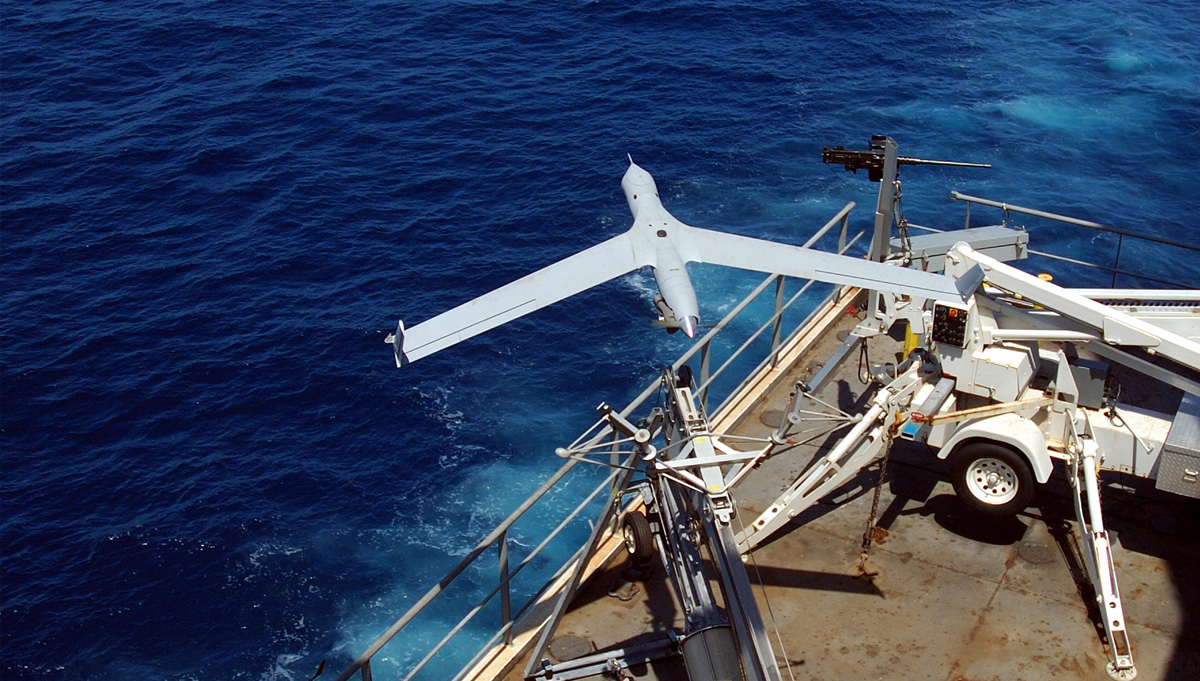Insitu’s ScanEagle platform has now close to one million flight hours. The Unmanned Aerial System (UAS) from Boeing’s wholly owned subsidiary recently completed a demonstration of its capacities to the Royal Navy as well as military and industry officials from across the globe.
The ScanEagle drone from Insitu showcased its newest wide-area maritime surface search and identification technology during the Royal Navy’s Unmanned Warrior demonstration. During the event, held in Benbecula, Scotland, the Insitu team was tasked to perform a range of maritime missions using ScanEagle equipped with the ViDAR payload. Developed in collaboration with Australia-based Sentient Vision Systems, ViDAR is the only maritime surface search with automatic target finding capability on a group two unmanned platform.ViDAR successfully and reliably detected objects through changing environmental conditions ranging from clear sun to wind, rain, haze and fog. ViDAR is the world’s first Wide Area Motion Imagery (WAMI) automated detection system for the maritime domain. Small, light and self contained, ViDAR allows effective primary search with smaller UAVs and aircraft without radar, dramatically improving the cost effectiveness of maritime operations such as search and rescue, maritime patrol, anti-piracy, anti-narcotics and border protection.Agile, virtually undetectable and on station until the job is done, the ScanEagle delivers persistent imagery on land or at sea at a fraction of the cost of other surveillance methods. The aircraft’s live video feeds keep you one step ahead of the situation, whether your mission is agricultural assessment or force protection. And because no nets or runway are required, you can keep your footprint small, even when the stakes are big.During the Unmanned Warrior 2016, the ScanEagle flew more than 55 hours, covering an area more than twice the size of Wales (41,500 km²) and using fewer than eight gallons of fuel. The ScanEagle UAS flew more hours than any other participating platform.Despite sometimes challenging weather, ScanEagle with ViDAR autonomously detected hundreds of large and small objects in sea state six conditions. These included spotting and positively identifying two mine sweepers by number, spotting smaller objects such as stationary jet skis and buoys at 5 nm and locating 28 contacts from one sortie in fewer than two hours.“During one flight our team spotted a target 19 nm away before the exercise began,” said Suzanne McNamara, vice president of business development for Insitu. “ScanEagle with ViDAR is a force multiplier that will establish a new standard for global navies. We are extremely proud of the successes we achieved during Unmanned Warrior and look forward to supporting our customers with this advanced capability.”“In one mission ViDAR was called upon to find a small commercial fishing vessel transiting towards the northbound NATO naval MCM group. The vessel was not registering on radar, but was on AIS. ViDAR successfully detected and identified the vessel within seconds” said Simon Olsen, Sentient’s Director of Business Development, Strategy and Partnerships. “In another, ViDAR was tasked with seeing if it could find Fast Attack Craft (FAC) at range in order to provide early warning to a vessel of small inbound threats.” The ScanEagle was positioned at the extent of its range within the airspace allocated for the mission. Within moments of starting its run, ViDAR autonomously detected the FAC out beyond 13nm. This fast detection and identification of such a small threat gave the protected vessel over 30 minutes of advance notice in which to act – game changing in terms of the extra time it provides to vessels to respond to potential threats.”ViDAR fits into ScanEagle as a modular slice that comprises a high-resolution digital camera that continuously scans the ocean in a 180-degree arc in front of the air vehicle. The ViDAR software then autonomously detects any object on the surface of the ocean, providing the ground control station with an image and location coordinate of each object detected in real time. The spotter sensor can then be cross-cued to the object for closer inspection.In May, Sentient and Insitu confirmed the signing of an exclusive global distribution agreement for the ViDAR software for unmanned systems within the small UAS weight class. ScanEagle is the first and only unmanned platform to fly this payload.Subscribe
The information you submit will be stored and used to communicate with you about your interest in Commercial UAV News. To understand more about how we use and store information, please refer to our privacy policy.
December 14, 2016
ScanEagle Drone and ViDAR for Maritime Search and Rescue
















Comments